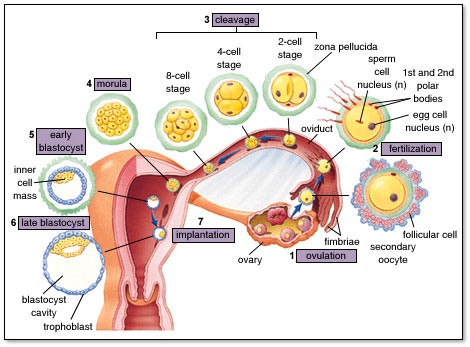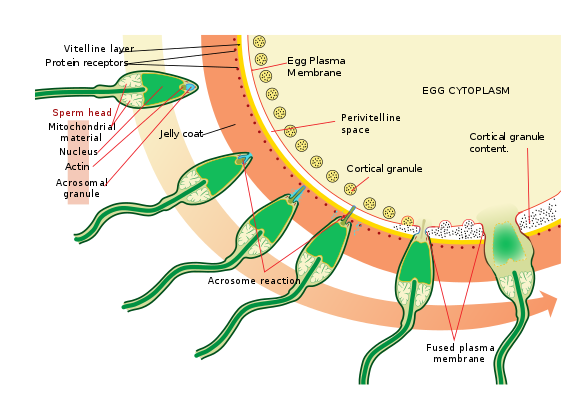Fertilization Study Guide
Introduction
Fertilization is referred to as the fusion of the male gamete (sperm) with the female gamete (egg) to form an embryo. It usually occurs within the fallopian tube of the female, after which the fertilized egg implants itself into the walls of the uterus.
Events preceding Fertilization
1. Insemination
During the act of sex, the male releases sperm into the female’s vagina near the cervix (copulation). This is referred to as insemination. A single ejaculation might contain up to 300 million sperm.
2. Movement of sperms into the fallopian tube
- Sperms migrate up through the uterus from the vaginal canal, but only a few thousand make it to the fallopian tube openings.
- Millions of sperm are swallowed by leucocytes (immune cells) of the vaginal epithelium.
- Uterine and fallopian tube contractions first aid sperm movement, but they eventually travel on their motility (with the help of the tail).
- Sperm travel 1.5 to 3 mm per minute across the fluid medium to reach the location.
3. Movement of the secondary oocyte into the fallopian tube
- The secondary oocyte is discharged from an ovary’s mature Graafian follicle (ovulation).
- The oocyte is accepted by the adjacent fallopian funnel (finger-like projections at the end of the fallopian tube helps in this process) and guided into the fallopian tube by ciliary movements.
- Only 24 hours after its release from the ovary, the secondary oocyte can be fertilized.
- After that, the secondary oocyte will degenerate.
- A large number of sperm surround the secondary egg, yet only one sperm successfully fertilizes the oocyte.
- The sperm penetrates the secondary oocyte when the second meiotic division progresses.
- The entrance of sperm into the secondary oocyte completes the second meiotic division.
- Ovum is the name given to the secondary oocyte after the entry of sperms.
4. Capacitation
- The secretions of the female genital tract enable the sperm in the female genital tract to fertilize the egg.
- Coating chemicals produced on the surface or head of sperms, particularly those on the acrosome, are removed by these female genital tract secretions.
- As a result, the receptor sites (helps in the recognition of sperm by the secondary oocyte) on the acrosome are accessible, allowing sperm to reach the egg.
- Capacitation is the term for the phenomena of sperm activation in animals.
- Capacitation takes around 5 to 6 hours.
- Seminal vesicles, prostate gland, and bulbourethral glands (Cowper’s glands) secretions in the semen include nutrients that activate the sperm.
- The secretions of these glands also neutralize the acidity in the vaginal canal.
- The sperms become more active in alkaline media.
Events During Fertilization
1. Acrosomal reactions
- The acrosomal response causes the capacitated sperms to release the substances stored in the acrosome. Sperm lysins are the aggregate name for these compounds.
- The sperm lysins, hyaluronidase (which helps the sperms to penetrate the follicular cells), corona penetrating enzyme (which dissolves corona radiata), and zona lysine or acrosin (which aids in the digestion or dissolution of the zona pellucida) are all important.
- The plasma membrane of the sperm fuses with the plasma membrane of the secondary oocyte as a result of an acrosomal reaction, allowing the sperm contents to enter the oocyte.
- Depolarization of the oocyte plasma membrane occurs when sperm binds to the secondary oocyte (this prevents the entry of multiple sperms in the ovum).
2. Cortical reactions
- The secondary oocyte exhibits a cortical response.
- The cortical response is a mechanism in which the sperm unites with the egg’s plasma membrane, shortly after fertilization.
- This prevents polyspermic fertilization or entry of multiple sperms in the ovum shortly after the sperm and plasma membranes of the oocyte fuse.
- The cortical granules of the secondary oocyte can be found underneath the plasma membrane.
- Between the plasma membrane and the zona pellucida, these granules fuse with the oocyte’s plasma membrane and release their contents, including cortical enzymes.
- These enzymes stiffen the zona pellucida, preventing more sperm from entering (polyspermy).
3. Entry of sperm
- The secondary oocyte generates a protrusion called the cone of reception or fertilization cone that accepts the sperm when it comes into touch.
- The sperm’s distal centriole divides into two centrioles, resulting in a mitotic spindle for cell division.
- The secondary oocyte (egg) of a mammalian does not have its centrioles.
4. Karyogamy
- The secondary oocyte is stimulated by sperm entrance to complete the second meiotic division that has been paused.
- A haploid mature ovum and a second polar body are produced.
- The nucleus-containing head of the sperm splits from the central portion and tail to form the male pronucleus.
- The sperm tail and the second polar body degenerate.
- The female pronucleus is the new name for the ovum’s nucleus.
- The pronuclei of the male (nucleus/genetic material of sperm) and female pronuclei move closer to each other.
- The nuclear membranes of these cells disintegrate.
- Karyogamy mixes the chromosomes of a sperm and an ovum.
- The zygote is the fertilized ovum (egg).
In humans, the zygote is a diploid unicellular cell with 46 chromosomes.
Significance of Fertilization:
- It restores the diploid number of chromosomes, which is 46 in humans.
- Cleavage (a division of cells in the early embryo) begins with fertilization.
- It adds centrioles to the mature egg, which are missing.
- Fertilization results in the embryo’s sex is determined.
- It brings together the traits of two parents. Variations are introduced as a result of this.
- The fertilization membrane that forms after the sperm enters the ovum stops additional sperm from entering the ovum.
Conclusion:
- The fusion of male gamete (sperms) and female gamete (ovum) to form a diploid zygote is called fertilization.
- The process of fertilization occurs mostly at the ampullary-isthmic junction of the oviduct in humans (Fallopian tube).
- Sperm-ovum recognition, cortical reaction, entry of sperm in ovum(plasmogamy), mixing of sperm and egg nucleus (karyogamy) are the four basic steps of fertilization.
FAQs:
1. What is the fertilization process?
Fusion of haploid male and female gametes to form a diploid zygote is known as fertilization.
2. What are the 4 steps of fertilization?
- Sperm-ovum recognition
- Cortical reaction
- Entry of sperm In ovum(plasmogamy)
- Mixing of sperm and egg nucleus (karyogamy)
3. Can two sperms enter one egg cell?
This type of fertilization reaction where two sperms simultaneously enter the ovum is extremely rare in humans, but it is possible. Embryos formed through this type of fertilization do not survive.
4. How long can sperm live?
Inside the female body, sperm can survive for upto 5-7 days.
5. Where do sperm and egg join together?
Sperm and egg fuse together in the fallopian tube of the female’s body. More accurately, fertilization takes place inside the ampulla of the fallopian tube.
6. How does fertilization take place?
- When sperms and ovum simultaneously meet each other in the ampulla of the fallopian tube, fertilization takes place.
- Sperm binds to the ovum, and after a series of reactions, the sperm is engulfed whole inside the ovum.
- After that, the genetic material of sperms and ovum combine to give rise to a diploid zygote.
We hope you enjoyed studying this lesson and learned something cool about Fertilization! Join our Discord community to get any questions you may have answered and to engage with other students just like you! Don’t forget to download our App to experience our fun, VR classrooms – we promise, it makes studying much more fun! 😎
Sources:
- Fertilization. https://flexbooks.ck12.org/cbook/ck-12-biology-flexbook-2.0/section/13.65/primary/lesson/fertilization-bio/. Accessed on 30 Nov, 2021.
- Pregnancy and Conception. https://www.webmd.com/baby/understanding-conception. Accessed on 30 Nov, 2021.
- Fertilization. http://www.vivo.colostate.edu/hbooks/pathphys/reprod/fert/fert.html. Accessed on 30 Nov, 2021.



